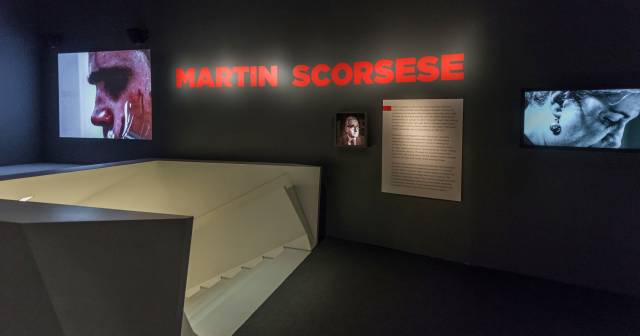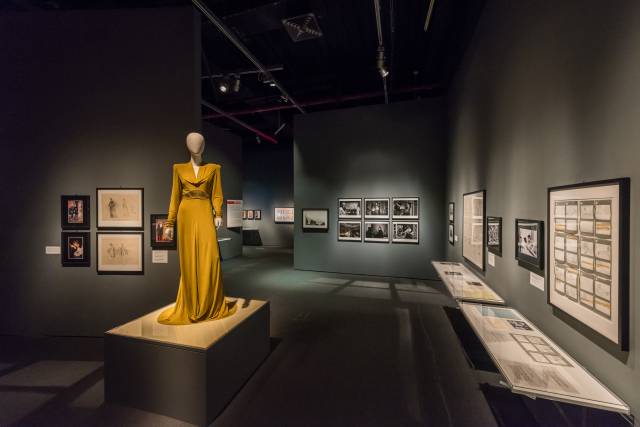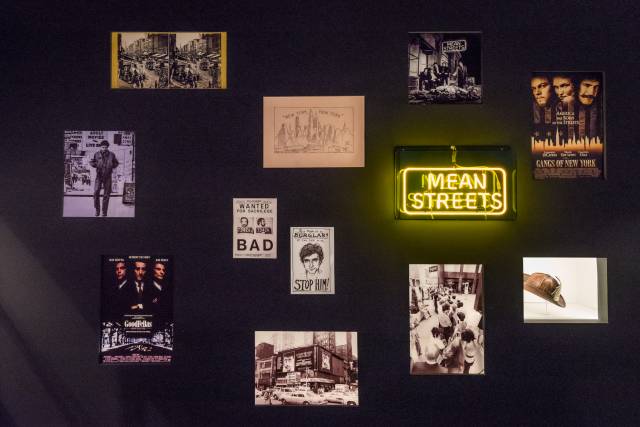

Few filmmakers have changed the way we perceive cinema like Martin Scorsese. From his breakthrough Mean Streets, to the operatic beauty of Raging Bull, and the classic Hollywood feel of his majestic The Aviator, he redefined what films were supposed to look and sound like. Working in both fiction and documentaries, he has also nurtured the work of cinematic artists like editor Thelma Schoonmaker, costume designer Sandy Powell, and actors like Robert De Niro and Leonardo DiCaprio, with whom he has collaborated frequently. To celebrate his legacy, the Museum of the Moving Image will host Martin Scorsese (December 11-April 23, 2017), an exhibit organized by the Deutsche Kinemathek – Museum für Film und Fernsehen, Berlin.
Presenting countless artifacts from Marty’s personal life and career, including records he owned as a young man (which he would then use in some of the soundtracks to his films), a storyboard he made at age 11, annotated screenplays, as well as props and costumes from films like Gangs of New York, the Palme d’Or he won for Taxi Driver, and precious items he’s collected from films he loves, the exhibit will be sure to delight and inspire cinephiles who will find themselves in the presence of genius. Curators Nils Warnecke and Kristina Jaspers were kind enough to answer some of our questions about the exhibit.
Did you find any similarities between the process of putting together the exhibit and filmmaking?
Kristina: Yes, sometimes the process of preparing an exhibition reminds us on the process of filmmaking. The keyword is the “narration” or the storytelling. For this you need a strong concept, good ideas that you could communicate visually, a structure that gives you a good rhythm and a creative team to realize the project together.
Nils: And also working with so many different crafts and media reminds me of making a film. The process shows similarities. As Kristina already said you need a story you want to tell and a kind of script. Then you have to deal with the space you will use. You have to create the architecture, you have to choose colors, design the light, decide how to present objects, add text and maybe sound, and, in the case of doing a show about film, of course, clips, compilations, and media installation. So in the end a lot of creative people are involved like in the process of making a movie.

What was the challenge in narrowing down the themes of the exhibit? Were there any themes that were discarded?
Kristina: We organized the exhibition thematically and not chronologically. We tried to find a way to give the audience a special impression of the Art of Scorsese and his distinctive style. That is the reason why we combined personal items like photos from his Italian American family and pictures that he made with his still camera in the 1950s with images from his own movies. We are starting with his typical characters like the “Lonely Heroes”, going into his main location “New York”, showing Scorsese as Cineaste (or Cinephile) who is interested in the preservation of the film heritage and knowing everything about movies. In the last chapter we are explaining the style: how he “composes” movies through the cinematography, the editing in music. So to be honest – all the main aspects we want to show, are in.
What is your single favorite object in the exhibit?
Kristina: There are so many objects that are unique, it is really hard to talk only about one. For me the storyboards in the exhibition are the key to the understanding of his work. Just have a look at the Storyboard for Raging Bull – it is brilliant! Every single shot, the perspective, the angle, every detail of the composition is in here. In the vitrine you will find a note by Scorsese that he had the shower sequence of Psycho in mind when he was drawing the storyboard for Raging Bull. Both sequences are masterpieces in film editing (so we also have to speak about Thelma Schoonmaker) and using time and sound... Scorsese is doing the storyboarding very early in the creative process. For me they are like "conceptual art", and they show (similar to Alfred Hitchcock) his visual concept of filmmaking, his kind of "visual narration".
Nils: Like for Kristina it is hard for me to tell. But let's say and I follow up on what Kristina has said the very early storyboard that Scorsese draw when he was only 11 years old. That was the time when he went to the cinema around the corner to see American classics of the time (the early 1950s) and to see black-and-white Italian movies on television. The storyboard shows the opening titles and the first sequence of an epic film in ancient Rome. It's in color and CinemaScope and he claims it to be a “Marsco (Martin Scorsese) Production” and the cast brings together only top Hollywood actors. What is so remarkable is that this 11 year old kid already knew so much about film and its technical aspects and that he had this vision to see himself as a famous Hollywood director. We have to remember that the environment he grew up in was the poor Italian community on the Lower East Side of Manhattan.

What is your favorite Scorsese movie?
Kristina: I really love the early movies like Who’s That Knocking On My Door or Mean Streets. They are rough and all the main topics are in there: The young boys, aggressive on one side, but also shy and sensitive on the other, standing between the mob, the church, and the love of a young girl. I think in many of Scorsese’s movies you will find these young men trying to find their way in life, trying not to stay alone, also searching for a kind of spirituality.
Nils: I do agree but would like to add two more titles. Alice Doesn't Live Here Anymore. Not the typical Scorsese plot but a great film with a fantastic Ellen Burstyn acting in it. And Casino. The characters (and again I have to praise a Scorsese actress Sharon Stone!!), the story and especially the way it's done, the different layers of sound, the editing, the pace, and the joyful entertainment it provides in addition to a retrospect on a Las Vegas that has disappeared. In general Scorsese is a brilliant and important chronicler of American history.
Which of his movies do you feel has remained underappreciated and hope the exhibit will make people see in a different light?
Kristina: I hope that we could light up some strong leading actresses in Scorsese’s movies. There are some female parts that I really like a lot, like the role of Ellen Burstyn in Alice or Michelle Pfeiffer in The Age of Innocence. It is important to note the Scorsese created some very touching female characters. Remember Liza Minnelli in New York New York or Sharon Stone in her outstanding role in Casino! So maybe the exhibition could open the view on this a bit unknown side in his oeuvre.
Nils: A film I didn't know before was The King of Comedy. And I love it. I hope more people will discover it.
Martin Scorsese will be open to the public from December 11-April 23, 2017. For more information visit the Museum of the Moving Image’s official website.